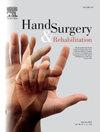肩胛骨腕间韧带成形术治疗肩胛骨不稳的临床、放射学和动态 CT 结果。
IF 0.9
4区 医学
Q4 ORTHOPEDICS
引用次数: 0
摘要
对肩胛骨腕间韧带成形术的临床、放射学和 4D 计算机断层扫描结果进行了至少 2 年的随访评估。29 名患者(23 名男性和 6 名女性)患有慢性肩胛骨不稳,平均年龄为 40 岁(22-57 岁不等),均接受了肩胛骨腕间韧带成形术治疗,其中 18 人患有动态不稳,11 人患有静态不稳。患者的平均随访时间为 61 个月(24-94 个月)。掌骨腕间韧带成形术明显减轻了疼痛,增强了握力和腕关节功能。在X光片上,平均静态和动态肩胛间隙以及肩胛角和桡骨角均有明显改善。所有病例的肩胛骨背侧脱位都得到了矫正。术后的四维计算机断层扫描能更精确地分析恢复腕骨内侧对齐的效果。背侧闰节不稳和背侧肩胛骨半脱位的矫正得到了证实。肩胛骨腕间韧带成形术恢复了桡肘偏离运动时肩胛骨腕间间隙的正常范围,但没有系统性地减少两块骨头之间的平均距离和最大距离。在最后的随访中,没有患者因肩胛骨晚期塌陷而出现桡骨和/或中掌骨关节炎的症状。证据级别:iii。本文章由计算机程序翻译,如有差异,请以英文原文为准。
Clinical, radiological and dynamic CT results of scapholunate intercarpal ligamentoplasty for scapholunate dissociation
A clinical, radiological and four-dimensional computed tomography (4DCT) assessment of the outcomes of scapholunate intercarpal ligamentoplasty (SLICL) was done with a minimum follow-up of 2 years. Twenty-nine patients (23 men and 6 women) with a mean age of 40 years (22–57) who had chronic scapholunate dissociation were treated with the SLICL procedure. There were 18 cases of dynamic instability and 11 of static instability. The patients were evaluated with a mean follow-up of 61 months (24–94). SLICL significantly reduced pain and increased grip strength and wrist function. On radiographs, the mean static and dynamic scapholunate gaps as well as the scapholunate and radiolunate angles improved significantly. The dorsal scaphoid displacement was always corrected. 4DCT after surgery provided a more precise analysis of the SLICL’s effectiveness at restoring intracarpal alignment. Correction of the DISI deformity and dorsal scaphoid displacement was confirmed. SLICL restored a normal variation in the scapholunate gap (range value) during radioulnar deviation movement without systematically reducing the distance between the bones (mean and maximum values) which remained pathological in wrists with static instability but not in those with dynamic instability. At the final follow-up, no patients had signs of osteoarthritis due to ScaphoLunate Advanced Collapse.
Level of evidence
III.
求助全文
通过发布文献求助,成功后即可免费获取论文全文。
去求助
来源期刊

Hand Surgery & Rehabilitation
Medicine-Surgery
CiteScore
1.70
自引率
27.30%
发文量
0
审稿时长
49 days
期刊介绍:
As the official publication of the French, Belgian and Swiss Societies for Surgery of the Hand, as well as of the French Society of Rehabilitation of the Hand & Upper Limb, ''Hand Surgery and Rehabilitation'' - formerly named "Chirurgie de la Main" - publishes original articles, literature reviews, technical notes, and clinical cases. It is indexed in the main international databases (including Medline). Initially a platform for French-speaking hand surgeons, the journal will now publish its articles in English to disseminate its author''s scientific findings more widely. The journal also includes a biannual supplement in French, the monograph of the French Society for Surgery of the Hand, where comprehensive reviews in the fields of hand, peripheral nerve and upper limb surgery are presented.
Organe officiel de la Société française de chirurgie de la main, de la Société française de Rééducation de la main (SFRM-GEMMSOR), de la Société suisse de chirurgie de la main et du Belgian Hand Group, indexée dans les grandes bases de données internationales (Medline, Embase, Pascal, Scopus), Hand Surgery and Rehabilitation - anciennement titrée Chirurgie de la main - publie des articles originaux, des revues de la littérature, des notes techniques, des cas clinique. Initialement plateforme d''expression francophone de la spécialité, la revue s''oriente désormais vers l''anglais pour devenir une référence scientifique et de formation de la spécialité en France et en Europe. Avec 6 publications en anglais par an, la revue comprend également un supplément biannuel, la monographie du GEM, où sont présentées en français, des mises au point complètes dans les domaines de la chirurgie de la main, des nerfs périphériques et du membre supérieur.
 求助内容:
求助内容: 应助结果提醒方式:
应助结果提醒方式:


